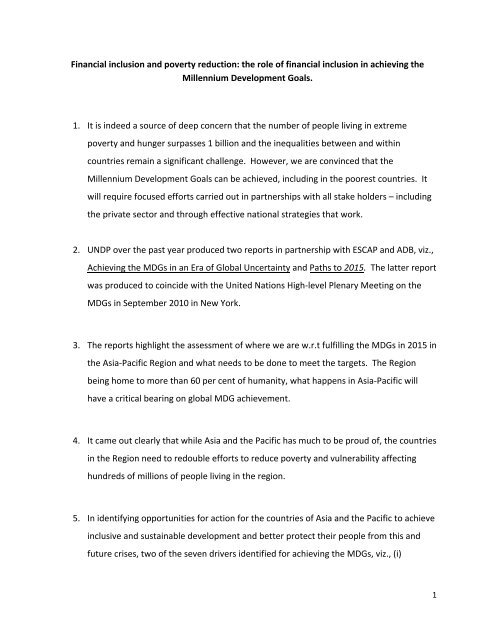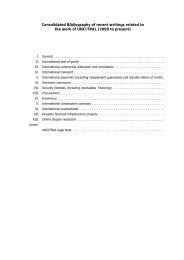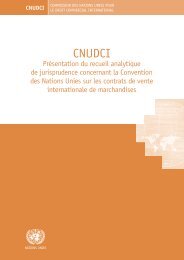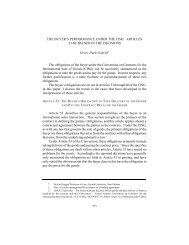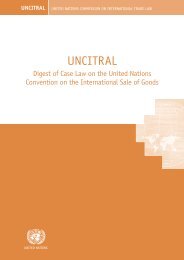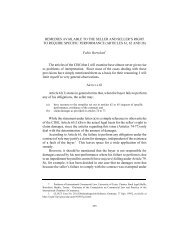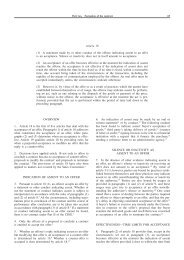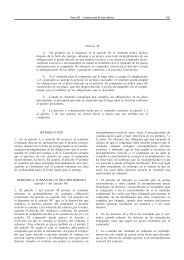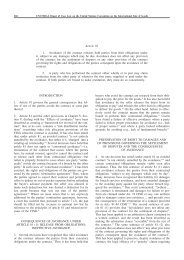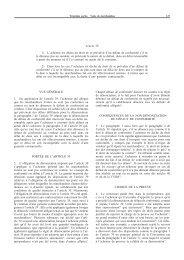Financial inclusion and poverty reduction: the role of ... - uncitral
Financial inclusion and poverty reduction: the role of ... - uncitral
Financial inclusion and poverty reduction: the role of ... - uncitral
You also want an ePaper? Increase the reach of your titles
YUMPU automatically turns print PDFs into web optimized ePapers that Google loves.
<strong>Financial</strong> <strong>inclusion</strong> <strong>and</strong> <strong>poverty</strong> <strong>reduction</strong>: <strong>the</strong> <strong>role</strong> <strong>of</strong> financial <strong>inclusion</strong> in achieving <strong>the</strong><br />
Millennium Development Goals.<br />
1. It is indeed a source <strong>of</strong> deep concern that <strong>the</strong> number <strong>of</strong> people living in extreme<br />
<strong>poverty</strong> <strong>and</strong> hunger surpasses 1 billion <strong>and</strong> <strong>the</strong> inequalities between <strong>and</strong> within<br />
countries remain a significant challenge. However, we are convinced that <strong>the</strong><br />
Millennium Development Goals can be achieved, including in <strong>the</strong> poorest countries. It<br />
will require focused efforts carried out in partnerships with all stake holders – including<br />
<strong>the</strong> private sector <strong>and</strong> through effective national strategies that work.<br />
2. UNDP over <strong>the</strong> past year produced two reports in partnership with ESCAP <strong>and</strong> ADB, viz.,<br />
Achieving <strong>the</strong> MDGs in an Era <strong>of</strong> Global Uncertainty <strong>and</strong> Paths to 2015. The latter report<br />
was produced to coincide with <strong>the</strong> United Nations High‐level Plenary Meeting on <strong>the</strong><br />
MDGs in September 2010 in New York.<br />
3. The reports highlight <strong>the</strong> assessment <strong>of</strong> where we are w.r.t fulfilling <strong>the</strong> MDGs in 2015 in<br />
<strong>the</strong> Asia‐Pacific Region <strong>and</strong> what needs to be done to meet <strong>the</strong> targets. The Region<br />
being home to more than 60 per cent <strong>of</strong> humanity, what happens in Asia‐Pacific will<br />
have a critical bearing on global MDG achievement.<br />
4. It came out clearly that while Asia <strong>and</strong> <strong>the</strong> Pacific has much to be proud <strong>of</strong>, <strong>the</strong> countries<br />
in <strong>the</strong> Region need to redouble efforts to reduce <strong>poverty</strong> <strong>and</strong> vulnerability affecting<br />
hundreds <strong>of</strong> millions <strong>of</strong> people living in <strong>the</strong> region.<br />
5. In identifying opportunities for action for <strong>the</strong> countries <strong>of</strong> Asia <strong>and</strong> <strong>the</strong> Pacific to achieve<br />
inclusive <strong>and</strong> sustainable development <strong>and</strong> better protect <strong>the</strong>ir people from this <strong>and</strong><br />
future crises, two <strong>of</strong> <strong>the</strong> seven drivers identified for achieving <strong>the</strong> MDGs, viz., (i)<br />
1
ensuring financial <strong>inclusion</strong> <strong>and</strong> (ii) streng<strong>the</strong>ning social protection are particularly<br />
relevant to <strong>the</strong> Colloquium <strong>and</strong> this session.<br />
6. <strong>Financial</strong> <strong>inclusion</strong> is critical to achieve inclusive growth <strong>and</strong> it is a prerequisite for<br />
sustainable economic growth <strong>and</strong> development. Harnessing <strong>the</strong> power <strong>of</strong> technology is<br />
one <strong>of</strong> <strong>the</strong> most effective ways <strong>of</strong> integrating <strong>the</strong> unbanked population into <strong>the</strong> financial<br />
mainstream <strong>and</strong> I underst<strong>and</strong> <strong>the</strong>re is a separate session on this topic. Technology<br />
enables <strong>the</strong> provision <strong>of</strong> a host <strong>of</strong> services from depositing money into various<br />
government schemes to micro loans <strong>and</strong> micro insurance. Uneven <strong>and</strong> inequitable<br />
growth has resulted in <strong>the</strong> exclusion <strong>of</strong> 51 percent <strong>of</strong> India’s population (560 million<br />
people) from formal sources <strong>of</strong> finance services, which is identified as a key cause <strong>of</strong><br />
<strong>poverty</strong>, toge<strong>the</strong>r with illiteracy.<br />
7. Sometime ago (2008) a Forbes article reported that an estimated 750 million<br />
households worldwide don't have a bank account. In Mexico, cash transactions<br />
constitute 79% <strong>of</strong> payments. In India 91%. In China, 82%. Even in <strong>the</strong> U.S., 80 m people<br />
are in <strong>the</strong> category <strong>of</strong> <strong>the</strong> under‐banked. Most people around <strong>the</strong> world, however, own<br />
a mobile phone.<br />
8. An ADB’s study found that rural financial markets in Asia are ill prepared for <strong>the</strong> 21 st<br />
century. It is mostly low‐income <strong>and</strong> rural individuals <strong>and</strong> micro‐ <strong>and</strong> small‐sector<br />
enterprises that are under‐serviced by <strong>the</strong> financial industry. And without transactional<br />
banking services, <strong>the</strong>ir financing is insecure <strong>and</strong> expensive <strong>and</strong> <strong>the</strong> disadvantaged<br />
people cannot participate fully in <strong>the</strong> economy ei<strong>the</strong>r as consumers or potential<br />
entrepreneurs. The unmet dem<strong>and</strong> for micro‐finance services is estimated to be nearly<br />
US$300 billion, <strong>of</strong> which <strong>the</strong> existing micro‐finance institutions (MFIs) supply only about<br />
US$15–25 billion.<br />
2
9. Lacking insurance or safety net mechanisms, <strong>the</strong> poor people cannot protect <strong>the</strong>ir<br />
meager assets <strong>and</strong> incomes against shocks such as illnesses or natural or man‐made<br />
disasters. A comprehensive social protection program will help minimize <strong>the</strong> risks <strong>and</strong><br />
vulnerability from economic crises <strong>and</strong> natural calamities, act as a ‘circuit breaker’ for<br />
vicious inter‐generational cycles <strong>of</strong> <strong>poverty</strong> <strong>and</strong> hunger. It will reduce widening<br />
disparities between <strong>the</strong> rich <strong>and</strong> poor <strong>and</strong> help countries in achieving <strong>the</strong> MDGs.<br />
10. These two drivers are related in that <strong>the</strong>y steer <strong>the</strong> ability <strong>of</strong> poor households to<br />
generate income <strong>and</strong> cash flows, <strong>and</strong> increase resilience. Inclusive finance, that for me<br />
includes safety net mechanisms, enables <strong>the</strong> poor to have livelihoods, jobs <strong>and</strong> even<br />
opportunities for entrepreneurship. In 2009, world unemployment rate was estimated<br />
at 6.6%. While it varies over regions <strong>and</strong> countries, a common factor that st<strong>and</strong>s out is<br />
that <strong>the</strong>re has been thus far slow progress in reaching full <strong>and</strong> productive employment<br />
<strong>and</strong> ensuring sustainable livelihoods for <strong>the</strong> poor <strong>and</strong> <strong>the</strong> disadvantaged. Sustainable<br />
livelihoods are critical to reducing <strong>the</strong> proportion <strong>of</strong> people living in absolute <strong>poverty</strong> by<br />
50% by 2015.<br />
11. As we creatively explore innovative options to mobilize <strong>and</strong> leverage additional<br />
resources to achieve <strong>the</strong> MDGs, I would submit that we need to carefully look at <strong>the</strong><br />
opportunities provided by remittances to enhancing access to inclusive finance <strong>and</strong><br />
making <strong>the</strong> unbanked <strong>and</strong> under‐banked bankable.<br />
12. International migration is a fundamental feature <strong>of</strong> globalization. The benefits <strong>of</strong><br />
migration are mostly through remittances to <strong>the</strong> country <strong>of</strong> origin <strong>and</strong> <strong>the</strong>y characterize<br />
<strong>the</strong> most tangible contribution <strong>of</strong> migrants to <strong>poverty</strong> <strong>reduction</strong>. Poor economic<br />
prospects in developing countries result in part <strong>of</strong> <strong>the</strong> family living <strong>and</strong> working in an<br />
industrialized nation <strong>and</strong> sending money to support family members who remain in<br />
<strong>the</strong>ir home country. Migrant remittances fundamentally differ from o<strong>the</strong>r financial<br />
3
flows in that <strong>the</strong>y represent a private transaction <strong>and</strong> are mainly a family affair based on<br />
social ties <strong>and</strong> networks <strong>of</strong> responsibility <strong>and</strong> affection.<br />
13. Over <strong>the</strong> past few decades, remittances have become increasingly prominent. Officially<br />
recorded remittance flows worldwide are estimated at around US$414 billion in 2009,<br />
with those to developing countries expected to have been around 316 billion (World<br />
Bank 2010).<br />
14. This amount, however, reflects only transfers through <strong>of</strong>ficial channels; <strong>and</strong> even<br />
<strong>of</strong>ficially recorded remittances are known to be measured with error. The balance‐<strong>of</strong>payments<br />
statistics produced by developing countries <strong>of</strong>ten neglect remittances<br />
received via money transfer operators <strong>and</strong> almost always exclude those transferred via<br />
informal means such as hawala operators, friends <strong>and</strong> family members, carried by<br />
travelers or sent by mail or money orders. These informal transfers may range anywhere<br />
from 20 per cent to 100 per cent <strong>of</strong> <strong>the</strong> <strong>of</strong>ficial statistics on remittances <strong>and</strong> would<br />
significantly enlarge <strong>the</strong> volume <strong>of</strong> remittances if <strong>the</strong>y were recorded. The true size <strong>of</strong><br />
remittances received by developing countries is believed to be well in excess <strong>of</strong> US$ 400<br />
billion. The latter figure when compared with <strong>the</strong> <strong>of</strong>ficial development assistance<br />
amount <strong>of</strong> about US$120 billion in 2009 clearly reflects <strong>the</strong> changing l<strong>and</strong>scape <strong>of</strong><br />
external financing in developing countries.<br />
15. So how does <strong>the</strong> changing financial l<strong>and</strong>scape as a result <strong>of</strong> remittances affects<br />
development, both actually <strong>and</strong> potentially, <strong>of</strong> <strong>the</strong> receiving countries (also termed<br />
countries <strong>of</strong> origin). Although migration <strong>and</strong> remittances by <strong>the</strong>mselves do not enable a<br />
country to escape <strong>poverty</strong>, <strong>the</strong>y can stimulate equitable development. The structural<br />
problems behind <strong>the</strong> persistence <strong>of</strong> <strong>poverty</strong> have to be addressed by <strong>the</strong> national<br />
governments. However, we believe that sizeable remittance inflows in a country <strong>of</strong><br />
4
origin provide <strong>the</strong> government with opportunities to create public goods <strong>and</strong> services by<br />
leveraging private transactions. While creating efficiency in money transfers <strong>and</strong> in <strong>the</strong><br />
use <strong>of</strong> <strong>the</strong> received amount at <strong>the</strong> household level, such a strategy can assist<br />
governments to create greater financial access <strong>and</strong> equity by catering for <strong>the</strong> unmet<br />
needs for financial goods <strong>and</strong> services <strong>of</strong> <strong>the</strong> poorer/vulnerable population.<br />
16. There is adequate empirical evidence that remittances represent a way out <strong>of</strong> <strong>poverty</strong><br />
for a significant population. Rural areas in developing countries tend to benefit <strong>the</strong><br />
most because much <strong>of</strong> <strong>the</strong> world’s migrants are drawn from <strong>the</strong>se areas. Studies by <strong>the</strong><br />
World Bank indicate that remittances cut <strong>the</strong> <strong>poverty</strong> rate in Ug<strong>and</strong>a <strong>and</strong> Bangladesh by<br />
11 per cent <strong>and</strong> 6 per cent, respectively, <strong>and</strong> raised education levels in El Salvador <strong>and</strong><br />
<strong>the</strong> Philippines. Despite complex economic <strong>and</strong> political circumstances in Nepal, <strong>the</strong><br />
country’s <strong>poverty</strong> headcount ratio declined by 11% points between 1995 <strong>and</strong> 2004, with<br />
one‐third to one‐half <strong>of</strong> this <strong>poverty</strong> <strong>reduction</strong> being attributed to remittances.<br />
17. Similarly <strong>the</strong>re is evidence from Mexico <strong>and</strong> Egypt re remittances accounting for nearly<br />
20 per cent <strong>of</strong> <strong>the</strong> capital invested in micro‐enterprises in urban Mexico <strong>and</strong> setting up<br />
<strong>of</strong> a number <strong>of</strong> enterprises in greater Cairo, using funds brought back from abroad.<br />
18. Generally speaking, remittances encourage consumption ra<strong>the</strong>r than productive<br />
investments. Never<strong>the</strong>less, remittances may promote development even when <strong>the</strong>y are<br />
spent on consumer goods. Evidence from Mexico shows that a dollar <strong>of</strong> remittance<br />
generates three dollars <strong>of</strong> spending power. And, remittance‐receiving households, when<br />
faced with favorable exchange rates, increase <strong>the</strong>ir investment‐related activities in such<br />
things as children’s education, self‐employment <strong>and</strong> launching capital‐intensive<br />
entrepreneurial activities.<br />
5
19. The propensity to save out <strong>of</strong> remittances has been consistently found to be nearly 40<br />
per cent across studies. In West Africa, in most savings‐based MFIs such as credit<br />
unions, village banks or savings <strong>and</strong> credit cooperatives, nearly six times as many people<br />
make deposits as take out loans at any one time. Despite <strong>the</strong> prevalent recognition that<br />
<strong>the</strong> poor have a high propensity to save <strong>and</strong> that <strong>the</strong>re is a considerable dem<strong>and</strong> for<br />
savings instruments as a result <strong>of</strong> increased remittances, even in Latin America fewer<br />
than 10 per cent <strong>of</strong> remittance recipients are estimated to have access to savings<br />
accounts, loans or o<strong>the</strong>r financial services. Access to commercial banks by low‐income<br />
<strong>and</strong> rural populations is limited in terms <strong>of</strong> physical distance to <strong>the</strong> closest branch <strong>of</strong> <strong>the</strong><br />
bank, thresholds in account fees or minimum required balances, <strong>and</strong> a lack <strong>of</strong> assets <strong>and</strong><br />
collateral opportunities for entrepreneurs.<br />
20. What do we have to do to leverage remittances to make financial services inclusive?<br />
That poor people are bankable <strong>and</strong> creditworthy is an important lesson learned after<br />
nearly three decades <strong>of</strong> micro‐credit activities. Despite <strong>the</strong> progress <strong>of</strong> micro‐credit<br />
initiatives, real involvement by <strong>the</strong> world’s largest financial institutions in this market or<br />
in leveraging <strong>the</strong>ir successes is anecdotal. There are currently examples <strong>of</strong> large private<br />
sector banks entering into risk‐sharing partnerships with non‐governmental or state‐run<br />
MFIs that merge social mobilization skills <strong>and</strong> a rural presence with <strong>the</strong> capital resources<br />
<strong>and</strong> financial credibility <strong>of</strong> a bank.<br />
21. Remittances provide a seamless opportunity to leverage such partnerships. The larger<br />
banks diversify <strong>the</strong>ir market opportunity by venturing into micro‐finance at lower<br />
transaction costs by partnering with MFIs that know <strong>the</strong>ir customers very well.<br />
Simultaneously, <strong>the</strong> existence <strong>of</strong> larger numbers <strong>of</strong> recipient households provides<br />
pr<strong>of</strong>itable prospects for MFIs, which can diversify <strong>the</strong>ir product platform by leveraging<br />
<strong>the</strong> expertise <strong>of</strong> larger institutions into tailored products to meet <strong>the</strong> needs <strong>of</strong> <strong>the</strong>ir<br />
clients.<br />
6
22. Along with <strong>the</strong> enhanced availability <strong>of</strong> savings <strong>and</strong> credit options, equally important<br />
are <strong>the</strong> terms on which <strong>the</strong>se services are available <strong>and</strong> whe<strong>the</strong>r <strong>the</strong>y are within <strong>the</strong><br />
reach <strong>of</strong> <strong>the</strong> clients <strong>and</strong> entrepreneurs. With remittance‐led increases in income levels,<br />
households have dem<strong>and</strong> for services that allow <strong>the</strong>m to manage <strong>the</strong>ir livelihood risks<br />
better – through, inter alia, access to micro‐insurance products – while reducing <strong>the</strong>ir<br />
vulnerabilities to external shocks <strong>and</strong> stresses.<br />
23. Additionally, MFIs would also have an opportunity to meet emerging dem<strong>and</strong>s for taking<br />
micro‐enterprises to a bigger scale, particularly by using evidence <strong>of</strong> remittances<br />
available to finance such ventures. This would streng<strong>the</strong>n <strong>the</strong> niche <strong>of</strong> MFIs, since a<br />
good number <strong>of</strong> small <strong>and</strong> medium‐sized enterprises (SMEs) need small loans, which<br />
banks, in general, are ei<strong>the</strong>r unable or unwilling to provide because <strong>the</strong> transaction<br />
costs are relatively higher <strong>and</strong> result in lower pr<strong>of</strong>its per loan.<br />
24. Even though savings products, home financing, insurance <strong>and</strong> small business loans are<br />
identified as financial services that generate <strong>the</strong>se benefits <strong>and</strong> have been <strong>of</strong>fered<br />
alongside remittances to ei<strong>the</strong>r remitters or recipients, <strong>the</strong> practice has been limited.<br />
There are barriers to entry in this market segment that represent significant challenges<br />
for <strong>the</strong> private sector including (i) unfamiliarity with <strong>the</strong> products required by <strong>the</strong> poorer<br />
segment <strong>of</strong> <strong>the</strong> population (ii) inadequate expertise to interact with this new client base,<br />
(iii) an inability to leverage new technologies for <strong>the</strong> provision <strong>of</strong> financial goods <strong>and</strong><br />
services, <strong>and</strong> (iv) emerging regulations in <strong>the</strong> money transfer market.<br />
25. Increasingly, MFIs are participating in <strong>the</strong> remittance market through <strong>the</strong>ir branch<br />
network as remittance payment points for money transfer operators. Because <strong>the</strong><br />
recipients are part <strong>of</strong> <strong>the</strong>ir core target consumer segment, this provides an opportunity<br />
for MFIs to cross‐sell o<strong>the</strong>r services in addition to generating additional income through<br />
fees <strong>and</strong> foreign exchange. The lower cost structure <strong>of</strong> <strong>the</strong> MFIs’ branch operations <strong>and</strong><br />
7
<strong>the</strong>ir presence in areas where banks do not <strong>of</strong>fer services, combined with <strong>the</strong>ir focus<br />
<strong>and</strong> interest in creating products for low‐income consumers, creates a viable business<br />
case that is not easy for commercial banks to replicate.<br />
26. However, MFIs levy relatively high interest rates – annual percentage rates (APRs) <strong>of</strong><br />
25–70 per cent – because <strong>of</strong> <strong>the</strong> higher overheads required for servicing unsecured<br />
small loans to people on <strong>the</strong> margins <strong>of</strong> society <strong>and</strong> occasionally in remote locations.<br />
The sometimes lower cost <strong>of</strong> capital available to MFIs running as a double bottom line<br />
business through subsidized loans from private, government <strong>and</strong> multilateral lenders<br />
brings greater sustainability to <strong>the</strong> micro‐finance business model. The micro‐finance<br />
market arena is an amalgam <strong>of</strong> commercial enterprises vying with social enterprises.<br />
Even though greater competition <strong>and</strong> scale should reduce <strong>the</strong> costs <strong>of</strong> micro‐finance<br />
services, many MFIs have not translated <strong>the</strong>ir efficiency <strong>and</strong> pr<strong>of</strong>itability into lowering<br />
<strong>the</strong> costs <strong>of</strong> servicing loans. The <strong>role</strong> <strong>of</strong> Compartamos Banco in Mexico <strong>and</strong> more<br />
recently SKS in India in evolving <strong>the</strong>ir for‐pr<strong>of</strong>it businesses aroused great controversy<br />
partly because <strong>of</strong> very high interest rates. As we link remittances to <strong>the</strong> provision <strong>of</strong><br />
inclusive financial services, <strong>the</strong> issue <strong>of</strong> transparency <strong>and</strong> disclosure around <strong>the</strong> rates is<br />
vital, particularly as MFIs are empowered to provide a broad range <strong>of</strong> financial services,<br />
including through linkage to remittances, ra<strong>the</strong>r than only small loans.<br />
27. With <strong>the</strong> still very limited involvement <strong>of</strong> MFIs <strong>and</strong> banks <strong>of</strong>fering services to remitters<br />
<strong>and</strong> recipients, money transfer currently is mainly a single‐service <strong>of</strong>fering that is<br />
processed separately from mainstream financial services, even if provided by financial<br />
institutions that have o<strong>the</strong>r products. Even though micro‐finance <strong>and</strong> micro‐insurance<br />
have integral links, <strong>the</strong> “mantra” that <strong>the</strong> poor are uninsurable still persists. There are<br />
opportunities that successfully demonstrate business models to connect <strong>the</strong>se services<br />
<strong>and</strong> <strong>the</strong> combination <strong>of</strong> micro‐finance with remittances can create viable possibilities to<br />
meet <strong>the</strong> unmet needs <strong>of</strong> <strong>the</strong> poor for <strong>of</strong> microinsurance while also increasing<br />
development benefits.<br />
8
28. Given that micro‐finance represents an entire range <strong>of</strong> financial products from credit,<br />
savings <strong>and</strong> insurance to payment <strong>and</strong> transfer services for <strong>the</strong> underprivileged<br />
population, <strong>the</strong> <strong>role</strong> <strong>of</strong> community‐based financial institutions such as rural banks, thrift<br />
banks, cooperatives, postal savings banks <strong>and</strong> MFIs in linking remittances to<br />
development is critical. Although <strong>the</strong>se institutions reach millions <strong>of</strong> financially underserved<br />
people <strong>and</strong> have self‐regulatory mechanisms, <strong>the</strong>y are not fully integrated in <strong>the</strong><br />
financial system. Mainstream private banks could play a vital <strong>role</strong> to enhance access to<br />
<strong>the</strong> benefits <strong>of</strong> inclusive financial services by <strong>the</strong> poor.<br />
29. In conclusion, given that <strong>the</strong> remittances – particularly by migrants with low skills –<br />
improve <strong>the</strong> welfare <strong>and</strong> quality <strong>of</strong> life <strong>of</strong> <strong>the</strong>ir recipient households, it is clear that this<br />
impact can be fur<strong>the</strong>r reinforced. It requires generating livelihood opportunities by<br />
improving access to financial services, alleviating risks <strong>and</strong> vulnerabilities, <strong>and</strong> enhancing<br />
financial literacy among <strong>the</strong> remitters as well as <strong>the</strong> recipients. The emphasis on<br />
livelihoods is vital. Just increasing access to financial services is not a solution to <strong>poverty</strong><br />
alleviation. It must go toge<strong>the</strong>r with ensuring that <strong>the</strong> recipient households have <strong>the</strong><br />
capabilities to exercise <strong>the</strong>ir options to access <strong>the</strong> services <strong>the</strong>y need to build assets.<br />
30. The national governments have an important <strong>role</strong> to play in facilitating/encouraging<br />
financial institutions to <strong>of</strong>fer remittance‐based financial products that are affordable<br />
<strong>and</strong> cater to <strong>the</strong> unmet dem<strong>and</strong> <strong>of</strong> <strong>the</strong> unbanked people. While, banks on <strong>the</strong> receiving<br />
side are playing a significant <strong>role</strong> in money transfer, <strong>the</strong>y have to be incentivized to<br />
exp<strong>and</strong> <strong>the</strong> range <strong>of</strong> <strong>of</strong>fer o<strong>the</strong>r financial services to <strong>the</strong> underprivileged. On <strong>the</strong><br />
originating end <strong>of</strong> remittances, currently, banks play an insignificant <strong>role</strong> <strong>and</strong> are having<br />
minimal impact on increasing access to banking services by <strong>the</strong> unbanked; this too can<br />
be diversified through creative financial practices to assist <strong>the</strong> poor including <strong>the</strong> use <strong>of</strong><br />
accounts receivables.<br />
9
31. In fact, working with <strong>the</strong> Governments in defining comprehensive social protection<br />
programs could be <strong>the</strong> first step – an important step ‐ in facilitating <strong>the</strong> participation <strong>of</strong><br />
<strong>the</strong> poorest <strong>of</strong> <strong>the</strong> poor in <strong>the</strong> micr<strong>of</strong>inance market making it fur<strong>the</strong>r inclusive. Targeted<br />
<strong>and</strong> gender responsive approaches to <strong>of</strong>fering minimum social floors to address<br />
extreme <strong>poverty</strong> <strong>and</strong> income security can significantly contribute to achieving MDGs<br />
including by creating sustainable livelihoods. For instance Bolsa Familia conditional cash<br />
transfer program <strong>of</strong> Brazil resulted in reducing <strong>the</strong> <strong>poverty</strong> rate from 42.7% to 28.8% in<br />
5 years <strong>of</strong> its starting in 2003. The National Rural Employment Guarantee Act (NREGA)<br />
introduced <strong>the</strong> system <strong>of</strong> payments to <strong>the</strong> workers through accounts opened in <strong>the</strong><br />
Banks or <strong>the</strong> Post Offices resulted in opening <strong>of</strong> 2.5 million accounts for <strong>the</strong> workers just<br />
in Karnataka State.<br />
32. The <strong>role</strong> <strong>of</strong> <strong>the</strong> private sector as an important change agent has to be complemented by<br />
effective government policies. These are necessary to create an enabling environment<br />
for attracting investments, ensuring competition, augmenting equity, inclusiveness <strong>and</strong><br />
social protection, use <strong>of</strong> new technologies <strong>and</strong> facilitating new markets. Public–private<br />
partnerships can widen <strong>the</strong> consumer base <strong>and</strong> create <strong>and</strong> enhance access to basic<br />
goods <strong>and</strong> services through appropriate delivery mechanisms <strong>and</strong> a transparent,<br />
accountable, participative <strong>and</strong> competitive environment.<br />
33. Simultaneously <strong>the</strong>re is a need to develop capacities at <strong>the</strong> human, institutional <strong>and</strong><br />
system‐wide levels to implement <strong>and</strong> enforce policies effectively for inclusive markets.<br />
Capacity development efforts have to be directed at (i) <strong>of</strong>fsetting <strong>the</strong> risk <strong>of</strong> new<br />
products for <strong>the</strong> commercial sector, (ii) creating greater access to unreached consumers,<br />
(iii) introducing new technology, (iv) enhancing consumers’ financial <strong>and</strong> technical<br />
education , (v) bringing in private sector entrepreneurial skills to improve <strong>the</strong> financial<br />
infrastructure, <strong>and</strong> (vi) setting service <strong>and</strong> credit st<strong>and</strong>ards.<br />
10
34. Multilateral <strong>and</strong> bilateral organizations in partnership with <strong>the</strong> private sector, Diaspora<br />
<strong>and</strong> o<strong>the</strong>r stakeholders can assist in creating toolkits <strong>and</strong> knowledge management<br />
systems to maximize <strong>the</strong> development benefits <strong>of</strong> remittances by linking <strong>the</strong>m to money<br />
transfers, savings <strong>and</strong> credit, micro‐insurance <strong>and</strong> micro‐pension schemes. By removing<br />
<strong>the</strong> barriers to link remittances to financial services – namely, a lack <strong>of</strong> trust in banking,<br />
financial illiteracy, <strong>and</strong> a lack <strong>of</strong> access to money transfer services – such partnerships<br />
can create opportunities for productive investment by migrants, recipients or local<br />
entrepreneurs. Although transnational social analysis can bring <strong>the</strong> micro, meso <strong>and</strong><br />
macro perspectives toge<strong>the</strong>r, greater learning‐by‐doing research is required to better<br />
underst<strong>and</strong> <strong>the</strong> multiple layers <strong>of</strong> this apparently simple but intricate relationship.<br />
11


